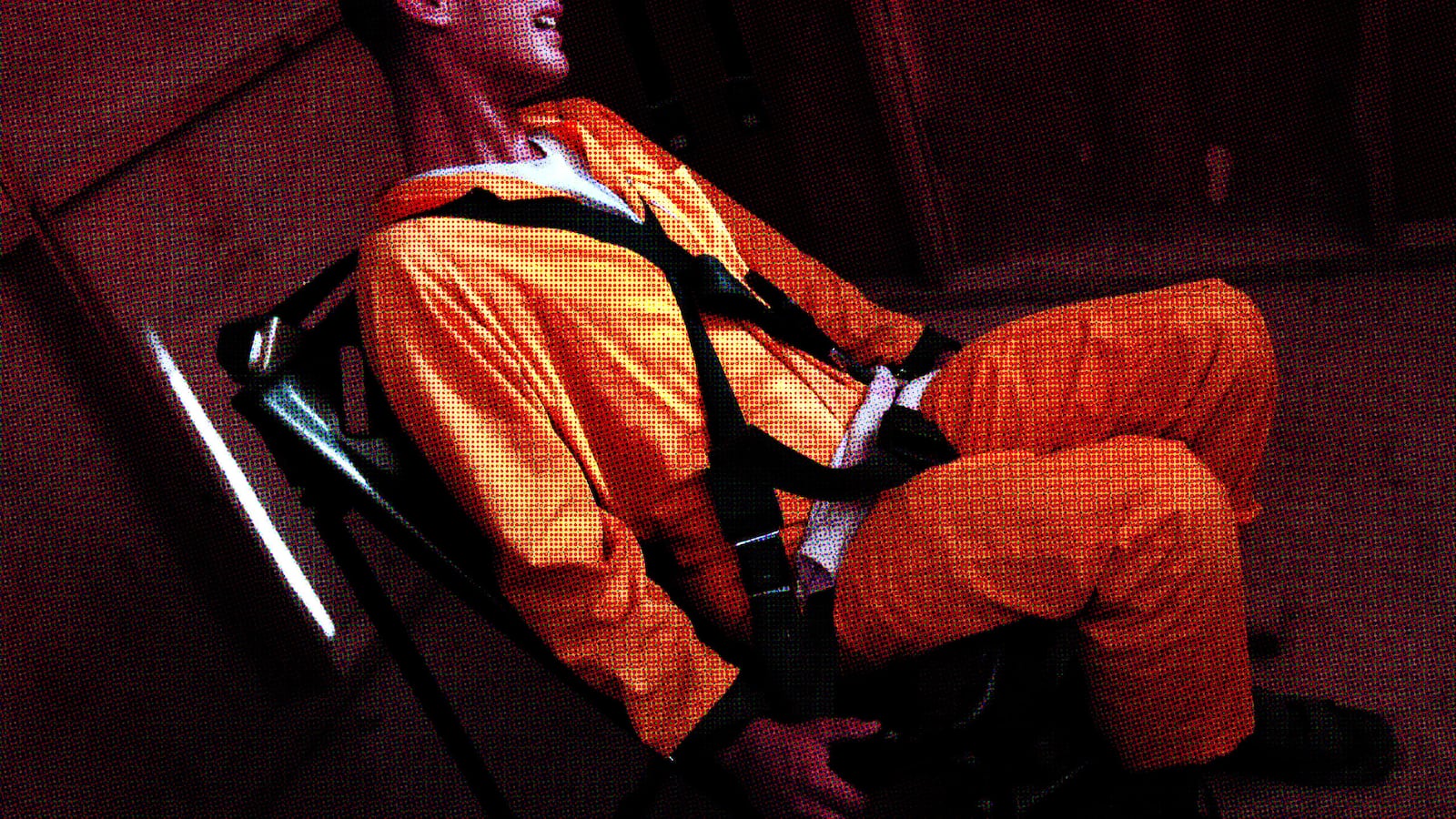At the CIA’s detention site Cobalt, the lights were never turned on.
The site was blacked out at all times, with curtains and painted exterior windows. It was this location where some of CIA’s the most gruesome detainee abuse occurred, according to the Senate Intelligence Committee’s review of the CIA’s interrogation programs released Tuesday. Ultimately Cobalt housed, at one point or another, nearly half of the 119 detainees identified by the report.
The CIA detainment and interrogation program can be, in many ways, told through the story of the hellhole the Cobalt site became: brutal techniques, little oversight, and unchecked abuse in the early years after 9/11, in the name of national security.
One of the lead interrogators at Cobalt once said that it was an effective place for interrogations because it is the closest he has seen to a “dungeon.” Detainees who had been through the site, apparently in Afghanistan, called it the ‘Dark Prison,’ while the agency referred to it as the ‘Salt Pit.’
The CIA was alerted of allegations that anal exams at Cobalt were conducted with “excessive force.” An attorney was asked to follow up, but no records indicate what happened next. Agency records said that one of the detainees housed at Cobalt, Mustafa al-Hawsawi, was later diagnosed with chronic hemorrhoids, an anal fissure, and symptomatic rectal prolapse.
Nude prisoners were kept in a central area, and walked around as a form of humiliation. Detainees were hosed down while shackled naked, and placed in rooms with temperatures as low as 59 degrees Fahrenheit. Loud music was played constantly.

In one case a detainee was dragged naked along the dirt floor. Detainee Gul Rahman’s clothes were cut off, and CIA interrogators put a hood on Rahman’s head. They slapped and punched him, and when he fell, dragged him through the dirt. Rahman was later found dead, with hypothermia the suspected cause.
One senior interrogator said that detainees “could go for days or weeks without anyone looking at him,” and that his team found a detainee who had been chained in a standing position for 17 days, “as far as we could determine.”
Some of the detainees at Cobalt “literally looked like a dog that had been kenneled,” the interrogator said, cowering when doors to their cells were opened.
A senior CIA debriefer told the agency’s Inspector General that she heard stories of detainees at Cobalt hung on days for end with their toes barely touching the ground, choked, being deprived of food, and made the subject of a mock assassination.
Detainees there were subject to sleep deprivation, shackled to bars with their hands above their heads. In fact, four of 20 cells at Cobalt were found to have bars across the cell to allow this.
The mismanagement and abuse at detention site Cobalt can be traced at least in part to a CIA officer identified in the Senate Intelligence Committee’s report as ‘CIA Officer 1.’ This officer had no experience in handling prisoners or conducting interrogations, and other CIA officers had questioned whether the officer’s access to classified information should continue due to a “lack of honesty, judgment and maturity.” He continued as a manager of Cobalt until July 2003.
In 2002, CIA Officer 1 ordered that Gul Rahman’s clothing be removed and shackled to the wall such that he could only rest on the concrete floor. The next day, Rahman’s dead body was found, and the resuscitation efforts of a CIA employee proved unfruitful.
The medical officer who conducted the autopsy said the clinical impression for the cause of death was hypothermia, although the report itself said Rahman’s death was undetermined. In March 2003, just four months after Gul Rahman was found dead, a CIA station recommended that CIA Officer 1 receive a $2,500 cash award.
Self-described 9/11 mastermind Khalid Sheikh Mohammed was also kept at Cobalt after his March 2003 in Pakistan. After just a “few minutes” of questioning at Cobalt, he was subject to enhanced interrogation techniques. He was slapped, grabbed in the face, placed in stress positions, placed in standing sleep deprivation, and doused with water.
As a means of obtaining “total control over the detainee,” the then-chief of interrogations said, KSM was subject to rectal rehydration multiple times, without a determination of medical need.
But the enhanced interrogations were not effective with KSM, who appeared in the eyes of the interrogation team to “clam up” after they were used. Adopting a “softer Mr. Rogers’ persona” made KSM more cooperative, according to the team.
A senior CIA official later said that later waterboarding of KSM elsewhere appeared counterproductive, that the CIA had “lost ground” with KSM since this progress at Cobalt, and that the use of waterboarding “may poison the well.”
The public may never receive a full accounting of detainee treatment at Cobalt. Multiple uses of sleep deprivation, prolonged standing, nudity and “rough treatment” were never reported. During the earliest days of Cobalt’s existence, in 2002, there were almost no detailed records of the detentions and interrogations there.
In Dec. 2002, a CIA Renditions Group visited Cobalt asked asked for a review of the interrogation process and conditions, as well as a legal review, which CIA headquarters appears not to have done.
And throughout interviews conducted in 2003 with the Office of Inspector General, top CIA leadership and attorneys acknowledged they had little knowledge of Cobalt operations. Director of Central Intelligence George Tenet said he was “not very familiar” with the detention site, while CIA General Counsel Scott Muller said he was “not very familiar.” In Aug. 2003, Muller said he believed Cobalt was merely a holding facility.
The 2003 CIA Inspector General review also found there were no guidelines for enhanced interrogation techniques at Cobalt and that some interrogators were “left to their own devices” with prisoners.
By late Jan. 2003, Tenet had signed the first formal guidelines for interrogation and confinement. Detention facilities would not necessarily have to keep up with U.S. prison standards.
These guidelines meant that Cobalt met the standard—even though prisoners were kept in total darkness and isolation, with only a bucket for human waste and without sufficient heat in winter months. Indeed, a review conducted of operations at Cobalt between Jan. and April of 2003 concluded that the detention site satisfied Tenet’s 2003 guidelines.
Federal Bureau of Prisons staff said they were “wow’ed” by the facility because of the level of sensory deprivation and the starkness of the cells. “‘There is nothing like this in the Federal Bureau of Prisons,’” a CIA officer said, describing the officials’ reaction. “It was their collective assessment that in spite of all this sensory deprivation, the detainees were not being treated in humanely [sic].”
The CIA authorized more than $200,000 for the construction of Cobalt in June 2002, and the site began housing detainees in Sept. 2002. Although there were initially plans for a foreign country—likely the Afghan government—to operate the site, it was overseen by the CIA from the start.
Ridha al-Najjar was the first to be held at detention site Cobalt. He had been left hanging, by handcuffs and not allowed to lower his arms for 22 hours each day for two consecutive days. He was kept in total darkness, kept cold, had music blasted at him and was shackled and hooded. The CIA inspector general would later say that al-Najjar “became the model” for treatment of CIA detainees at Cobalt.
Cobalt also played a role in the detention of Arsala Khan, a detainee who the CIA concluded did not appear to be involved in plans or activities against the United States. The agency concluded that he should be released with a cash payment, but was instead transferred to U.S. military custody and held for an additional four years.
While Cobalt was one central location for American detainee abuse, it was hardly the sole place to feature what lawmakers and the president have called torture. Detainees were described, in graphic detail, being rectally fed against their will. One detainee was bent over for a rectal feeding that involved Ensure, the protein shake. And in perhaps the most graphic detail of the report, a detainee had his lunch—consisting of hummus, pasta, nuts and raisins—pureed and rectally infused.






